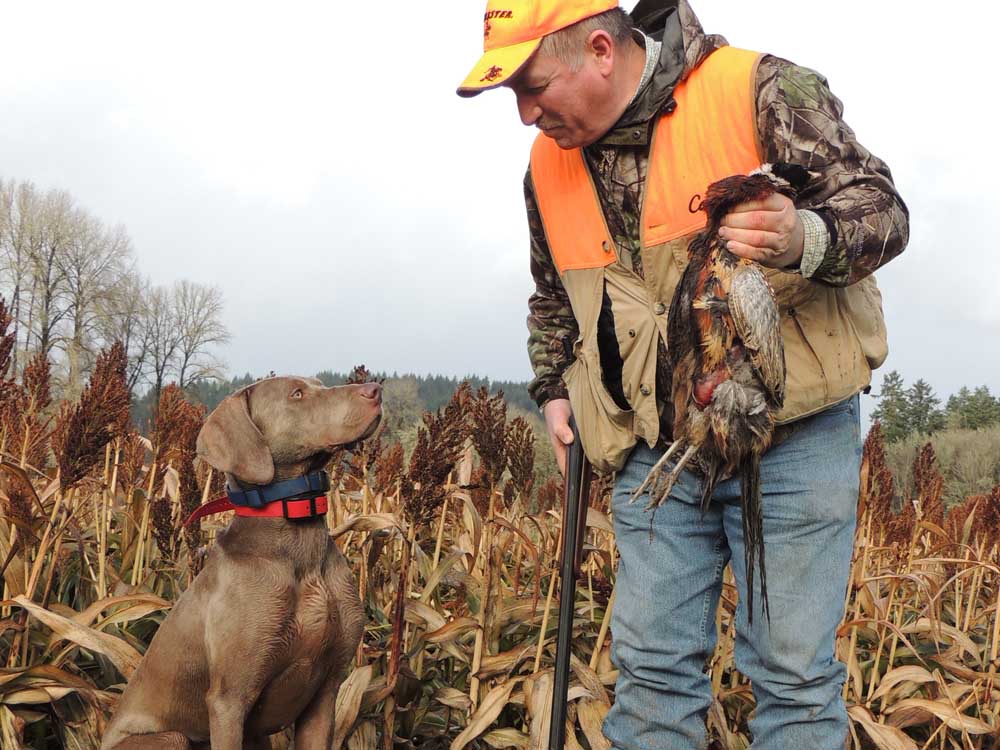Oregon’s best bets for late-season bird hunts
Published 12:00 am Wednesday, January 4, 2017

- Mike Faw and his dog, Cameron, with a rooster that the young weimaraner pointed and retrieved on a hunt in the Luckiamute Valley near Pedee.(Gary Lewis/For The Bulletin)
The Luckiamute was high and brown from heavy rain. We slowed down going through the town of Pedee so that we didn’t hit any Pedee-estrians; we then turned onto a gravel road and crossed the river.
It was my second time at Luckiamute Valley Pheasants, but the first for my dad, Don Lewis, who grew up in Western Washington and is no stranger to a bit of rain.
Mike Faw turned his dog, Cameron, a Weimaraner, out of the truck, and Keith Gran pulled his shotgun from the case. While we warmed our hands around the wood stove, Chuck Cates pointed out the course of our hunt on an aerial photo. We would start high on the hill in the Scotch broom and then work down into the corn and sorghum plots near the river.
My dog, Liesl, a 3-year-old pudelpointer, had been here once before when she seemed to forget everything she’d ever learned. The Weimaraner was too young to have forgotten anything, but not old enough to know much.
We drove up the hill, parked and worked south into the Scotch broom, with the wind in our faces. Gran and Dad took one side, Faw and I walked the other and the dogs ranged out front. The pup stayed close, turning his head often to check on his master. Liesl would circle back or change direction when I whistled.
We watched their body language, trusted their noses and walked around her when Liesl tightened on a turn and stabbed her nose into a 10-foot patch of Scotch broom. A rooster rocketed out and Keith was in the best position. The bird tumbled, and Liesl dashed for it, grabbed it and made a wide circle, looking for me to make the handoff.
We hunted for four hours, spending the most time in the standing corn and sorghum in the flat above the river. One pheasant made it across the river, and several others evaded us by going into the timber. We solved that problem by sending blockers ahead and to the sides while the dogs worked slow through the sorghum. Once, two roosters flew up, one after the other. Gran could claim a double on that sequence, but he had help.
At the end of it, Liesl and Cameron locked up in a narrow strip of corn.
They had a long-tailed ringneck pinpointed, and when we were close, he launched. When the rooster cackled and rattled up through the dry stalks, I should have been shooting a camera instead of the shotgun.
The ringneck pheasant season has wound to a close, but preserve hunting will continue through the end of March. For wild birds, the focus turns to grouse, quail, chukar and Hungarian partridge. Here are the best bets for late-season birds.
Forest grouse
Oregon’s forest grouse season offers a unique do-it-yourself opportunity, and the Imnaha Unit is a great place for both blues and ruffed grouse. With 74 percent as public lands in this game management unit, there is good access.
Several main roads branch away into the backcountry and offer various options. This is steep country, and many hunters will not venture deep into canyons that might hold grouse. Large parts of the Wallowa-Whitman National Forest are roadless, and someone who is willing to hike can find unpressured birds.
Mountain quail
For the best bird numbers, hunt the national forest and private timberlands west of Grants Pass, Medford and Ashland. Consider basing camp around Applegate, Selma or Cave Junction.
Typical grouse habitat is between 2,500 and 6,000 feet above sea level, in the regrowth of logging areas or burns. Since grouse inhabit steep, brushy hillsides, a good way to hunt is to ride logging roads or walk the ends of open ridges early and late in the day. Midday, watch the tree lines for resting birds.
Valley quail
If I had to pick one best place for quail, I’d head to the Cold Springs Wildlife Management Area near Hermiston, the McKay Reservoir area south of Pendleton, and Army Corps of Engineers lands on the Columbia. Before you go, pack nontoxic shot and check with headquarters for open hunt days. Another good way to find birds is to check out the Oregon Department of Fish and Wildlife Access and Habitat program on the web at www.dfw.state.or.us/lands/AH/hunting/index.asp. For information about hunt areas, contact the ODFW offices at the phone numbers listed with each property.
Chukar
Historically, chukar harvest runs highest in Malheur and Harney counties. The next highest harvest comes from the Columbia Basin, which includes Hood, Wasco, Sherman, Gilliam, Morrow and Umatilla counties.
My best hunts have been near Juntura and on the slopes of the Steens. With snow on the ground, a hunter should focus on the south-facing slopes where the wind has blown the white stuff away.
— Gary Lewis is the host of Frontier Unlimited TV and author of Fishing Central Oregon, Fishing Mount Hood Country, Hunting Oregon and other titles. Contact Gary at www.GaryLewisOutdoors.com.






